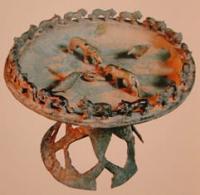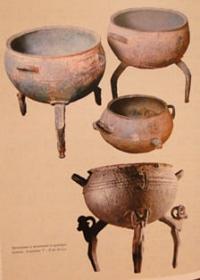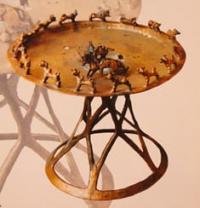You are here
Medieval town of Almaty.




History of medieval town of Almaty.
“In the Middle Ages, sedentary life here (in the Semirechie) greatly spread, especially in the Ili valley. The city of Almalyk (and now the Turkestan village), Khanakan and Kainak (which still exist) and Almaty (where the Vernoye fortification is now) were known for their trade and served as stations on the high road, along which Genoese merchants went to China and Kipchak ambassadors " great khan.
Chokan Valikhanov. "Essays on Dzungaria".
Pages of history of Almaty.
Area where city of Alma-Ata is now located has been inhabited since ancient times. It is known that from middle of the 1st millennium B.C. tribes of Saks lived here, who were engaged in cattle breeding, had a relatively high culture and knew various crafts.
At different times, a large number of monuments of the material culture of the Saks were found on the territory of Alma-Ata. So, for example, bronze bits were found, indicating that the Saks already used a horse for riding. In 1946, between the Kamensky Gorge and the Small Almaty River, at a depth of 80 cm, a bronze “cauldron with three legs in the form of the legs of an ungulate animal” was discovered.
A large bronze table-altar on four legs in the form of a predator's paws was found in the Bolshoy Almatinskaya village; on the corner of Gogol and Dunganskaya streets - a bronze cauldron, around which lay a large number of animal bones - a ram, a goat, a horse and a camel.
All these monuments belong to the Saka era and testify to the level of their culture. In the IIIrd century BC, in the same area there were “tribes of the Usuns (Uysuns), who at that time knew a sedentary and agricultural culture, as evidenced by such archaeological finds as millet grains, stone mortars and others.
A settled settlement of the Usuns was discovered to the south-west of the city of Alma-Ata, on the territory of the collective farm "Gorny Giant". A thin ash layer of a permanent camp of the Usuns was found here, with traces of hearths, household utensils, etc.
This parking lot is the first absolutely indisputable document of the beginning of settled life in the area where the city of Alma-Ata subsequently arose. The Usuns used wood in the construction business; the burial chambers of their burials were lined with Tien Shan spruce logs.
Such burials were discovered in the area of the fruit and vegetable plant, across the river Vesnovka. The Usuns were excellent craftsmen in the manufacture of gold jewelry. A remarkable example of their art is the so-called Karagaly diadem with a set of gold ornaments.
It is interesting that these decorations consisted of rings with images of two-humped camels, tau-teke, earrings in the form of a mouse and many different gold plates. The emergence of settlement and agriculture, the use of wood in the construction business, the high level of jewelry technology indicate that the Usuns, in comparison with the Saks, have gone far ahead in their cultural development.
Monuments of the time of the Huns' invasion in Semirechie (first centuries AD) are represented only by earthen graves, the burial chambers of which were lined with stone slabs. In the 6th century AD, the foothills of the Trans-Ili Alatau were occupied by the Dulu tribal union, whose main occupation was cattle breeding.
Monuments of this period are burial structures, which are burial pits lined with Tien-Shan spruce log cabins and covered with thin poles. From the outside, these structures look like mounds, near which stone statues were often placed, depicting in most cases a warrior.
Such stone sculptures in the Alma-Ata region were found more than once. In the era of the Western Turkic Khaganate (VI - VIII centuries), the same dulats lived here, who already had a settled way of life and agriculture in their infancy.
Only at the end of the VIIIth and beginning of the IXth century did intensive development of agriculture take place and settled settlements grow.
If we assume that the emergence of the city of Almaty dates back to this time, then its heyday, apparently, falls on the Karakhanid period, it is so reliably known that in this era trade flourishes in the Semirechye, old ones expand and new settlements appear along the routes of the great caravan road running from Maveranahr along the valley of the Chu River, through the ford Tai-Kechu, Kurdai pass, along the Zailiysky Alatau and through Alma-Ata.
There is some historical information about the existence of the city of Almaty in the Middle Ages. A prominent Kazakh scientist of the XIXth century, an expert on the history of Central Asia, Chokan Valikhanov, in his well-known work “Essays on Dzungaria” notes that “In the Middle Ages, settled here (in Semirechie) was very widespread, especially in the Ili valley.
The town of Almalyk (and now the Turkestan village), Khanakan and Kainak (which still exist) and Almaty (where the Vernoye fortification is now) were known for their trade and served as stations on the high road, along which Genoese merchants went to China and Kipchak ambassadors " great khan.
Somewhat later, in 1863, N. A. Abramov, a member of the Russian Geographical Society who visited the Vernoye fortification, wrote about the ancient city of Almaty: , where in the Middle Ages there was the city of Almaty, that is, the city of apples, known for its trade and serving as a station on the high road, along which, by the way, Genoese merchants went to China.
In 1893, Academician V.V. Bartold visited the ruins of this ancient settlement and, in the results of his inspection, wrote: “The ruins are located southwest of Verny, against the Bolshaya Almatinka gorge. According to the story of I. V. Gurda, the remains of brick buildings were recently visible here, and the directions of all the streets could be determined with accuracy, now all solid bricks have been taken away and only traces of buildings visible on the surface indicate the location of buildings and rooms".
I. V. Gurde, to whose message Academician V. V. Bartold refers, was at that time the city architect of Verny. Further, V. V. Bartold writes: “The news about the Ili Valley in the history of Timur’s campaigns is extremely uncertain. Almalyk is located south of Ili, from which we can conclude that it is not about Almalyk of Chinese sources, but about Almaty, near the present Verny: this is also confirmed by the fact that Timur’s army, moving from Almalyk and crossing the Ili, came to Karatal.
The same city is apparently meant by Juvayni, where it is said that Batu, on the way to the great Khan Guyuk, stopped in Almalyk, 7 days from Kyyalyk, and here he learned about the death of Guyuk. Almaty is also mentioned by Babur, in his time the city did not exist.
It is known that the Mongol invasion caused terrible damage to the cultural life of the entire Semirechye, caused the decline of agriculture and settled settlements. However, individual centers of settled culture in the Ili valley continue to exist. Among these, apparently, the city of Almaty has survived, as evidenced by the above messages.
From these reports it is clear that the city of Almaty existed not only in the era of Mongol rule, but also in the era of Timur, and according to Babur, a historian of the first half of the 16th century, the city no longer existed in his time.
Judging by these data, the following two assumptions can be made about the time of the death of the city.
According to the first assumption, Almaty was destroyed by Timur's troops on the way back and the campaign that took place in 1390 against the Mogblistan ruler, because when Timur's troops passed in the direction of Almalyk, the city of Almaty still existed.
And the ruins of the city of Almalyk (the name of which some historians of the Middle Ages erroneously called Almaty) are located on the right bank of the Ili River, to the north-west of the city of Ghulja; the famous tomb of Tukluk-Timur, described in detail by academician V. V. Bartold, is also located there.
According to the second assumption, Almaty could have been destroyed a little later - in the first decade of the 16th century, during the internecine wars of the locals! feudal factions. It is known that in 1508 in the region of Almaty one of the strongest battles took place between the ruler of Ak-su Mansur-khan and his brothers - Seit and Khalil.
Most likely, the death of the city refers to the era of Timur, when there were continuous military destructive actions. Catastrophic earthquakes and mud-stone flows could contribute to its disappearance. A detailed archaeological survey of the ruins of Almaty was carried out “in the spring of 1924 by V. D. Gorodetsky.
According to his survey, this settlement was a small settlement, the total area of which was approximately equal to 1.5 square kilometers. The part of the settlement located closer to the channel of the Vesnovka River was distinguished by the greatest population. V. D. Gorodetsky explains this circumstance by the fact that during the existence of the city, the Malaya Almatinka River flowed along the modern channel of the Vesnovka River.
By his definition, the turn of the Almatinka River to the east occurred a very long time ago and was caused by landslides that occurred during a catastrophic earthquake. As a result of the survey, traces of ancient ditches, a large number of mill embankments and buildings in the form of quadrangular rollers, the ruins of one large building, defined as a tower, were revealed.
Almost all buildings had stone foundations from river boulders. Judging by the remains of yards and buildings, the settlements had a rectangular planning system and a "manor" type of building with separate land plots for each house.
The remains of the courtyards have been preserved in the form of quadrangular ridges with sides measuring 18 x 40 meters. In addition to the above finds of different times, in the vicinity of this settlement were found copper coins of the Karahayid era, Zhagatai silver coins of the XIIIth - XIVth centuries, a flat stone weight, which served for weighing in mills.
The above meager information, of course, cannot give a complete picture of this disappeared city of the Middle Ages. We know almost nothing about the structure of his plan and the nature of the architecture. But nevertheless, on the basis of indirect data, we can somewhat supplement his characterization.
Research scientists have established some of the characteristic features of the settled settlements of the Ili Valley. These features are:
1). The cities of the Zailiysky Alatau were small in size,
2). They did not have the complex structure that is typical for the cities of South Kazakhstan and Central Asia, i.e. the cities of the Zailiysky Alatau did not have a clear division into a fortress, "shakharistan" and a craft suburb - "rabad",
3). The settlements of Semirechie were quadrangular fortifications, oriented by corners to the cardinal points, had powerful walls and gates reinforced with towers.
These characteristic features of the cities of the Trans-Ili Alatau, obviously, were also characteristic of the medieval city of Almaty - the predecessor of the modern city of Alma-Ata. During the annexation of the Trans-Ili Territory to Russia, there was a Kazakh village called Almaty, around which pastures, hayfields and arable land of Kazakh peasants from the tribe of dulats of the Elder Zhuz were located.
In 1854, the Zailiyskoye fortification was founded here, renamed Vernoye the following year.
Geographical coordinates of city of Almaty: N43°14'29 E76°55'04
Authority:
Mendikulov M. M. "Architecture of the city of Alma-Ata". Alma-Ata, 1953.
Literature:
L. K. Nifontova. “The latest archaeological receipts in the Central State Museum of the Kazakh SSR. News of the Academy of Sciences of the KzzSSR. Archaeological Series, no. 1, 1948, p. 123.
Ch. Valikhanov. Articles, correspondence. Alma-Ata, 1947, p. 73.
N. A. Abramov. "Almaty or Fortification Vernoe". Notes of R. G. O., vol. 1. St. Petersburg, 1867, p. 262.
V. V. Bartold. "Report on a trip to Central Asia for a scientific purpose", 1893 - 1894, p. 71.
V. V. Bartold. "Report on a trip to Central Asia for a scientific purpose", 1893 - 1894, p. 65.
V. D. Gorodetsky. “Remains of an ancient settlement south of Almaty (former Faithful)". Collection in honor of V.V. Barthold. Tashkent, 1927, p. 145.







